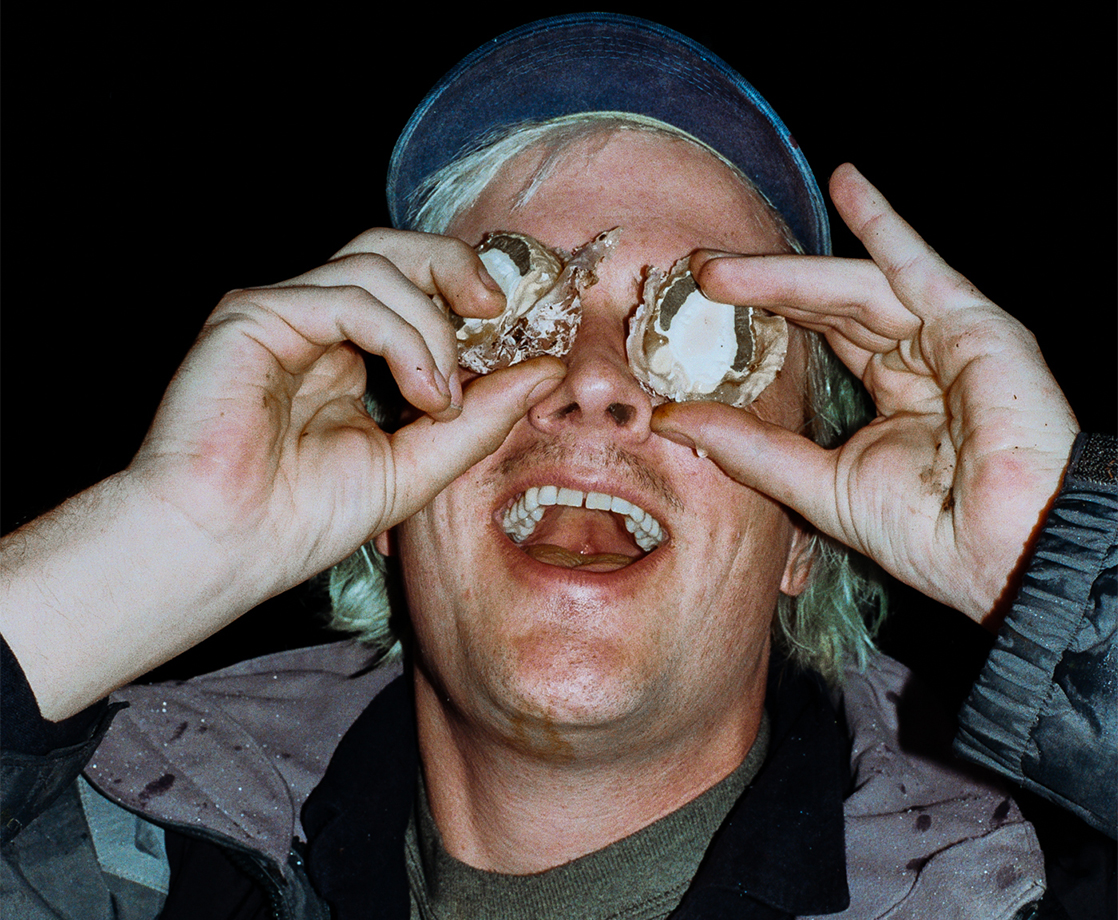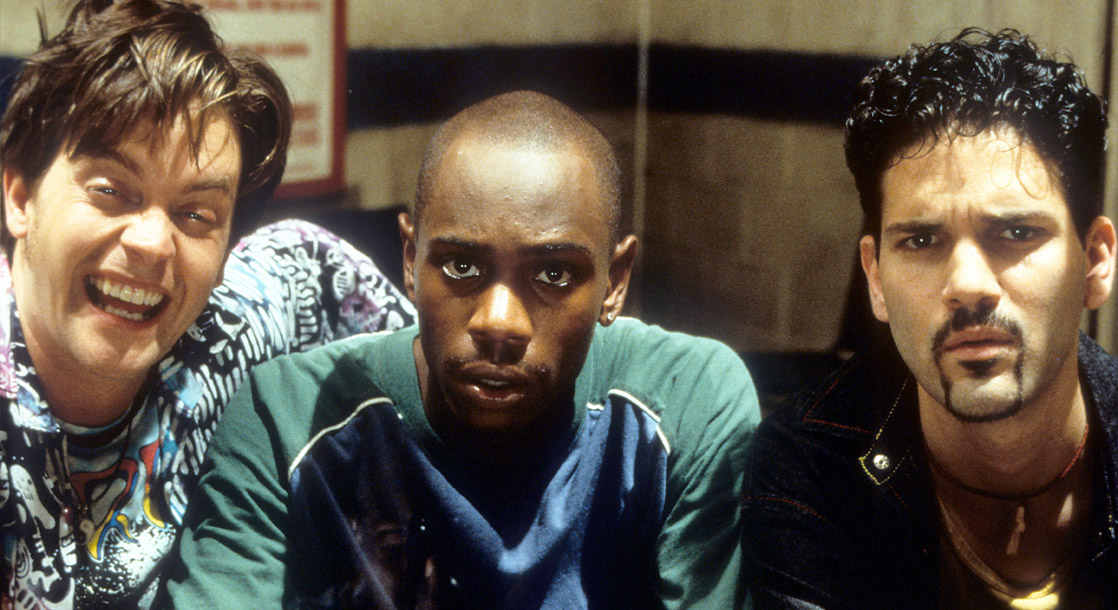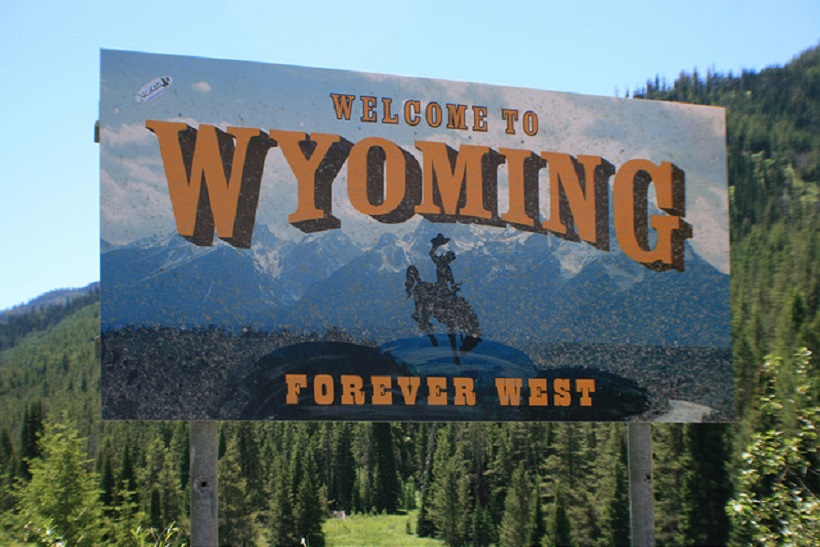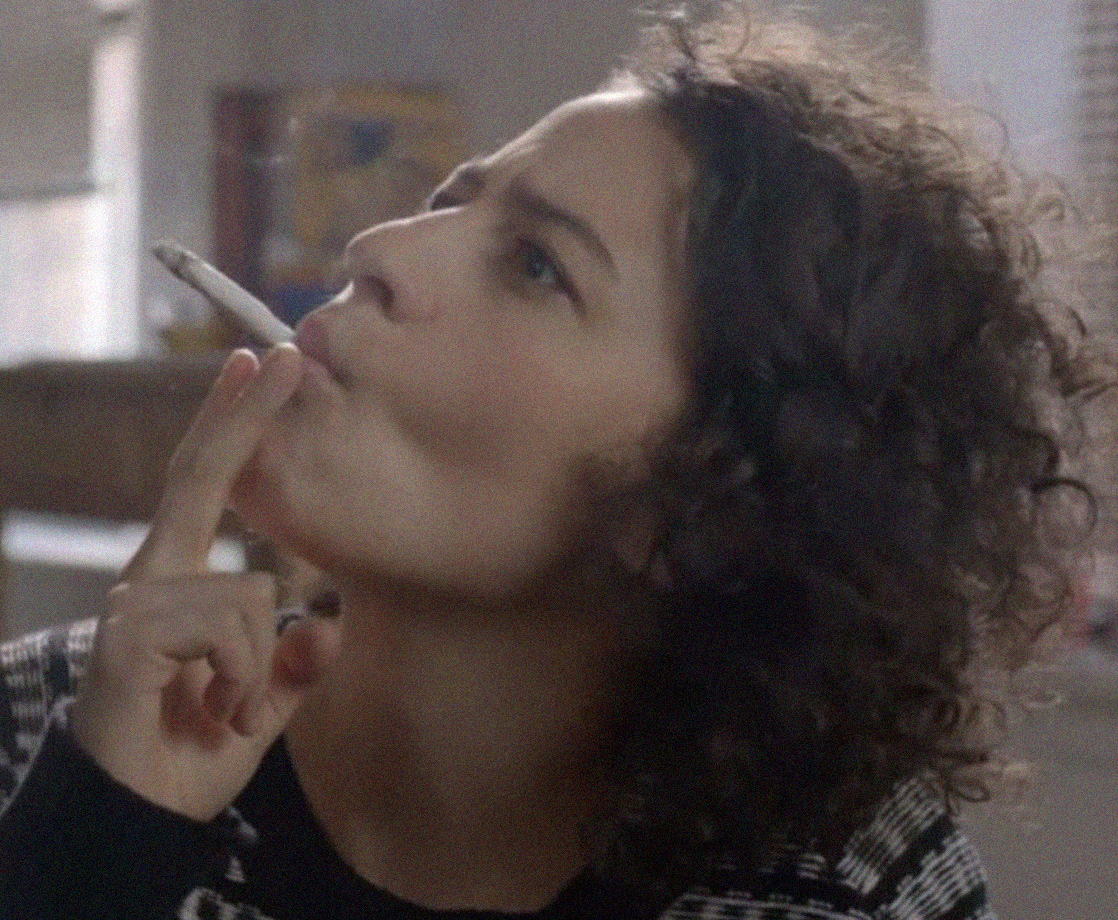All photos by OK McCausland
On a recent autumn weekend, I found myself huddled around a rotting stump at the pool of the Cornish Estate ruins near Cold Spring, New York.
As I craned my neck, Andrew Cannon — aka “The Fungus Fairy” — got down on his knees to point out a growth of slime molds covering the decaying chunk of wood. The fungus-adjacent clusters look like bubblegum pink pustules — rubbery, taut, and full of goo. We moved closer to watch as Cannon probed them with his dirt-covered fingers.
While he explained how the slime molds differ from fungus — how they are extremely intelligent and resourceful unicellular organisms — Cannon squeezed a pustule too hard and it burst. My hair and face were instantly covered in pink goo. It was a good omen for things to come on what was my first mushroom foraging adventure with this uniquely brilliant mycologist and artist.

Wolf’s milk slime (Lycogala epidendrum)
Andrew Cannon is a fungus fanatic. A self-taught forager, the 31-year-old has gained a small but loyal following on Instagram for his vivacious documentation of all things related to mushrooms. The Fungus Fairy may just be his social media handle, but it’s fair to describe him as one of the preeminent foragers in New York, a place most wouldn’t expect to be a hub for mushroom hunting. But if you’re to ask Cannon, you can find mushroom magic anywhere — though, to be clear, finding “magic” mushrooms is a different beast with geographic limitations.
Cannon also works as a multimedia artist, a practice that complements his mycological research, even if it’s not a one-to-one relationship. Originally from Redlands, California, he now resides in East Harlem and has a studio in Yonkers, New York, which offers easy access to nearby woodlands that are ripe for doing what he loves.
Our Cold Spring foraging trip was a fungal crash course, as well as an immersive vantage into how Cannon operates. Within minutes of our adventure, it became abundantly clear that this was no simple walk through the woods. Picture six of us on a trail, walking in silence as all our eyes were fixated on the ground. Every few moments, Cannon would wander off the path, trudge through leaves and fallen branches, climb up a tree, or dig under logs — always with a big bag to collect his bounty.

Above: Andrew Cannon (@fungus_fairy)
He can be a bit ruthless with fungus; when Cannon walks up to a mushroom, he looks at it, rips it out of the ground (or off a tree), explains its characteristics, and then takes a bite when applicable. Each time we found one on our excursion, he was just as excited as the previous discovery. He could name almost every species we came across, and when he was unfamiliar, he would open up an app that connects him to a global foraging community.
“Getting to know mushrooms year by year is a labor that I find rewarding and euphoric for its own sake,” Cannon told me in an interview after our nature walk. “Thoreau called his walks ‘appointments with plants,’ and that feels accurate to me — that there’s a kind of duty of friendship to the activity” of foraging. Part of his obsession comes from the fact that mushrooms “represent a whole other paradigm of nature — aesthetically and ecologically.”
It feels off to call Andrew an amateur. Sure, he wasn’t formally trained in mycology, but after a decade of non-stop research and foraging, he’s almost certainly put in his 10,000 hours. If anything, he’s a life-long autodidact with an interdisciplinary twist to his creative endeavors. Our deep dive into the woods was about as mind-expanding as it gets without the aid of psilocybin, and it’s clear that he’s a lifer when it comes to interacting with caps, stems, gills, and veils. On top of photographing our shroomtastic voyage, I chatted with Cannon about his passion for mushrooms, his tips for first-time foraging, and what’s next on his endless hunt for juicy fungus.

Above: Andrew holding Pluteus aurantiorugosus — a rare, brightly-colored wood decomposing fungi
MERRY JANE: Do you call yourself a forager? A self-taught mycologist?
Andrew Cannon: I’d say amateur mycologist, for lack of a better term.
When did you first become interested in mushrooms? What was it about mycology that drew you in?
As a kid in arid Southern California, I hardly thought about mushrooms beside the white buttons I’d pick out of my salad. I wasn’t particularly interested in biology either, but found I took to it when I ended up in an introduction to botany course while an undergrad. The class had a short section on fungi — which I found absolutely novel and bizarre — and somehow I was suddenly in love and thinking about them all the time. Honestly, it only gets worse every year.
I think a large part of it is the aesthetic; there were photos in the botany textbook of fungi in forms and colors that I hadn’t ever seen. No matter what you’re looking at, if you really get up close and look at fungi, they can be quite elaborate and peculiar pieces of architecture. And they just have so much charisma. They eat like we do — by parasitism or breaking down plant matter — and they’re capricious; they appear as if by chance and on their own time. They suggest a whole other paradigm of nature, both aesthetically and ecologically.
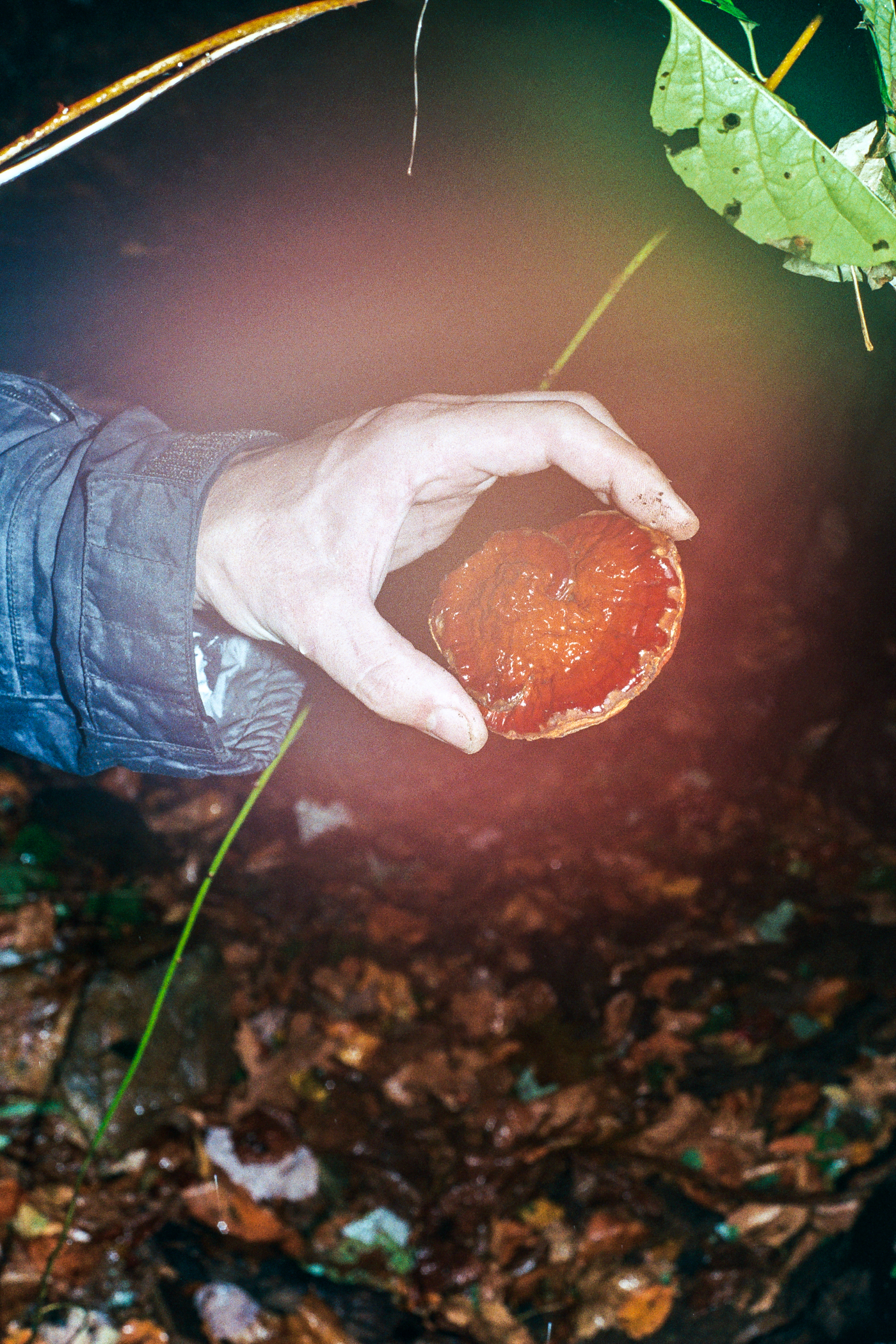
Above: Ganoderma sessile, one of the species of reishi found in our area of New York.
How did you originally educate yourself about mushrooms and foraging? Were there any pivotal texts or research materials?
After that botany class, I picked up The National Audubon Guide to North American Mushrooms by Gary Lincoff and All That the Rain Promises, and More by David Aurora — both classics. That summer, I was hiking in the Southern Sierra Nevada and saw some exceptionally large and beautiful boletes (which are a group of mushrooms with a tube layer — a bit like a sponge — instead of gills) and Amanitas (a genus of gilled mushrooms — the most famous species being the red capped toadstool with white spots: Amanita muscaria). I used my new books to roughly identify and learn more about them, and I found that some were edible and some were poisonous. I also learned that they had complex mycorrhizal (symbiotic) relationships with the trees I found them near. So, suddenly, fungi were a tangible thing, and I could find them and learn more about them.
I’d hiked my whole life with my family and had never noticed fungi, but this little bit of exposure reoriented my attention to the dirt and made the world more interesting. I started paying attention and saw fungi everywhere. For example, a huge cluster of honey mushrooms appeared on the tree outside of my apartment that winter as if I’d called them into existence. Soon, I was combing through the grass, looking at the miniature and fragile parasols that appear with the dew. Plus, I’d let stuff go moldy in my fridge to see what would grow. The next year, I joined the Los Angeles Mycological Society and bought more books and went on more hikes… and then I became that person who talks about fungi too much.
Wherever you are, look up guide books for your region. Look up mycological societies in your area. Post questions in online forums. Certainly, mycological societies are the fastest way to learn though. There’s no replacement for seeing the actual fungus in person, holding it, and having a local expert name it and hearing whatever they have to say about it.
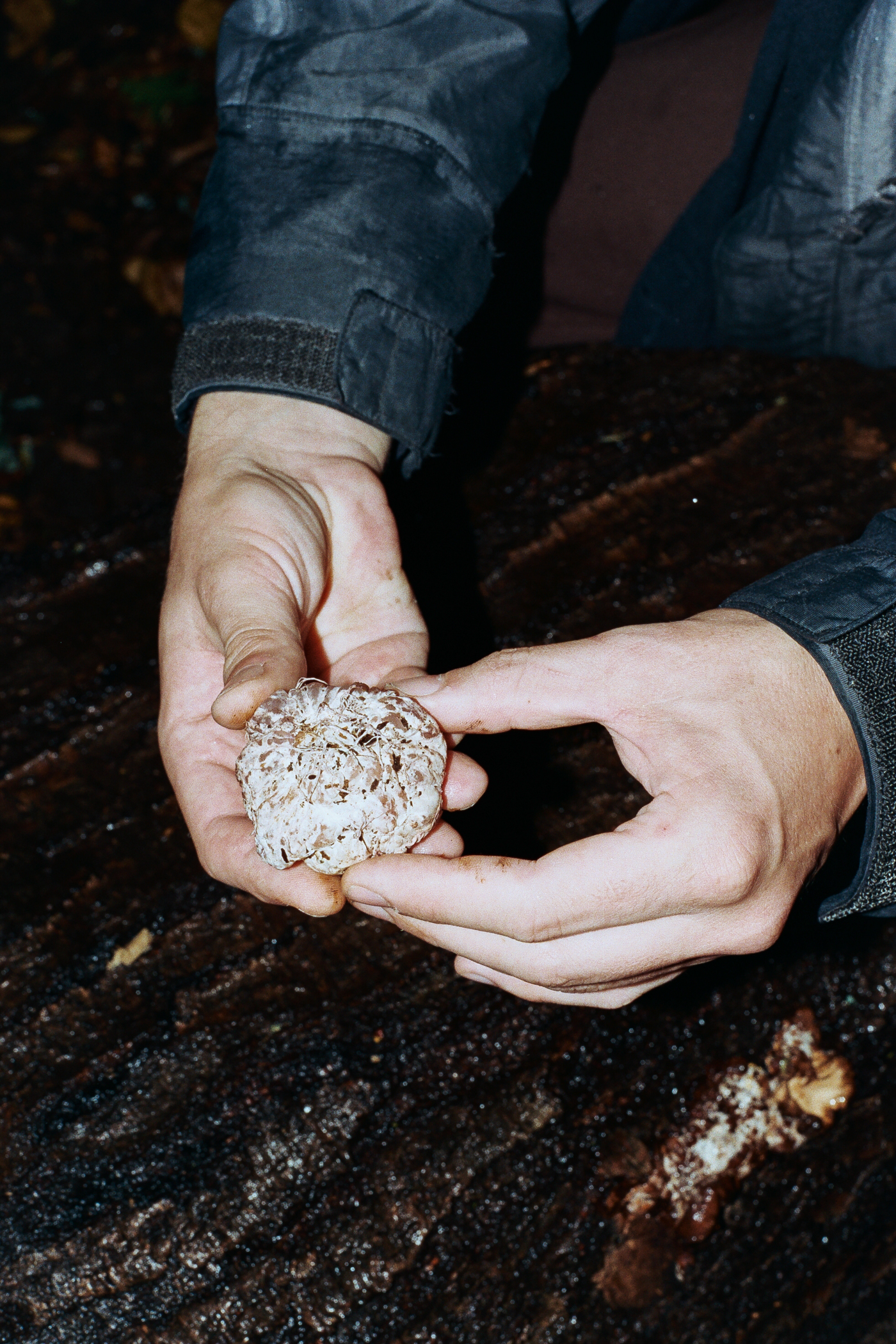
Above: Egg of the stinkhorn fungus, aka “Phallus impudicus”
Where did the name Fungus Fairy come from, and when did you adopt the name for your work?
It’s just an Instagram username that I’ll probably change again at some point. I do like Victorian fairy paintings, which often include depictions of fairies lounging on mushrooms. But the handle was mostly to signal that I was going to post a lot of images of fungi — and I do.
You have an art practice involving mushrooms. What does this entail, and where do you share or exhibit the work?
I wouldn’t say that my art practice involves mushrooms, not really. Making art and being interested in fungi are parallel interests, and they do overlap sometimes. I occasionally will make silicone molds of fungi, and the casts end up included in my work — though usually carved and refigured so that they’re not immediately apparent.
I think both interests stem from an impulse to look closely at the landscape and from wanting to understand it and be included by it. I often will work in my studio and then take a break to go for a walk in the nearby woods. Art can be just another job sometimes. It’s nice to have a separate thing that I care about and that I can escape into that isn’t transactional.
I haven’t really set out to accomplish anything artistically or scientifically with fungi. It’s more that getting to know them year by year is a labor that I find rewarding and euphoric for its own sake. Thoreau called his walks “appointments with plants,” and that feels accurate to me — that there’s a kind of duty of friendship to the activity.
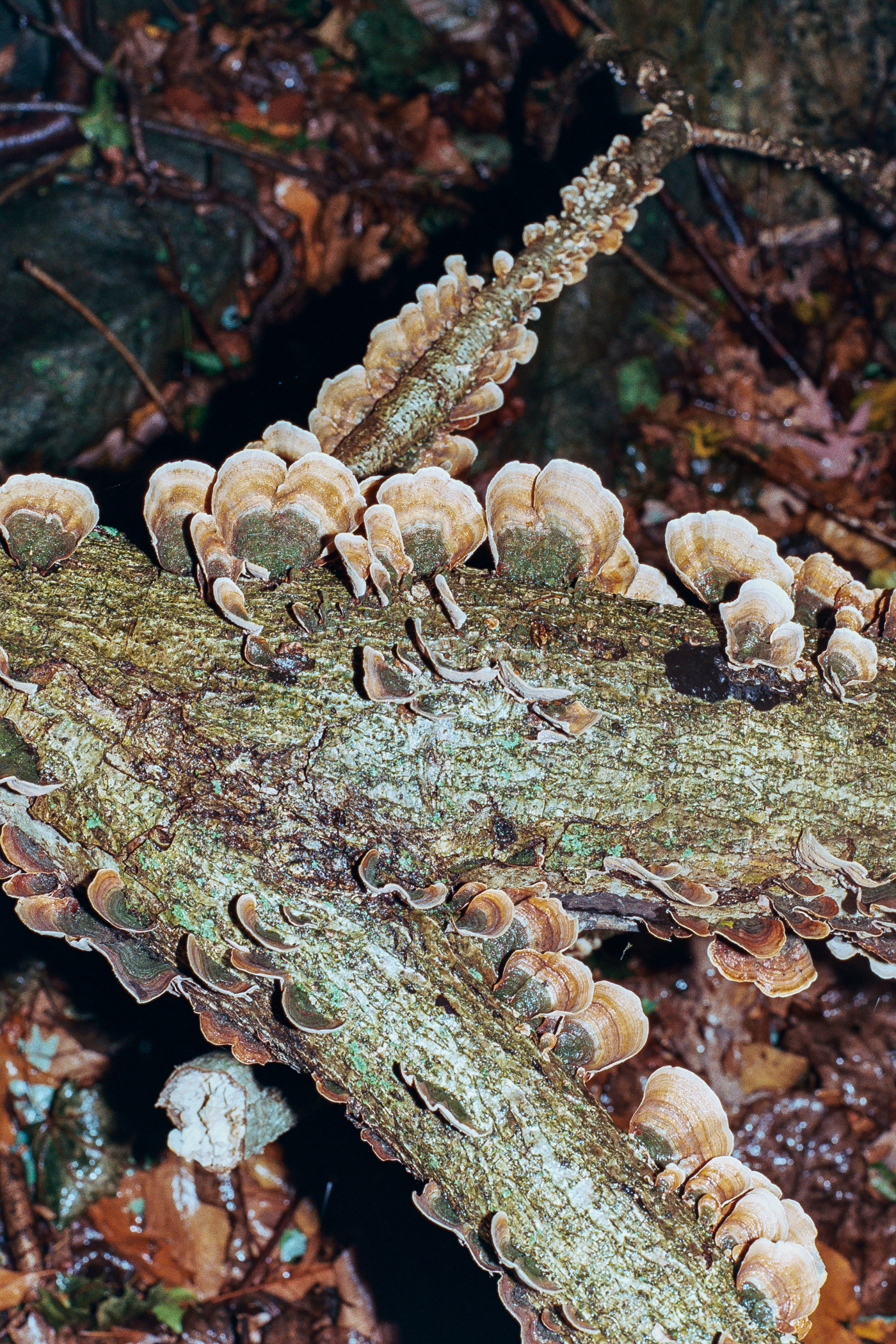
Above: Stereum ostrea
Where are your favorite places to forage regionally? What about nationally?
I’m fond of anywhere I go frequently. Now that I live in Manhattan, that’s Central Park and Van Cortlandt Park in the Bronx, and also my walk from the train to my studio. When I was in LA, it was Griffith Park and the Santa Monica Mountains and the lawns around me in Koreatown. Getting to know a landscape adds something — you get to know a forest like your own neighborhood. Or you get to know your neighborhood as a forest.
Some of my favorite finds have been on city streets. But in the forest you see the whole cycle of decomposition and renewal, and there’s a kind of four-dimensional awareness of what fungi appear and when, which fungi grow under which tree, in which seasons and climate, etc. It all adds texture to the activity. A fungus is quite different than a tree, for instance. A mushroom might not appear for years but still be present underground. There are fungi that aren’t seen for decades at a time.
In terms of destination hunting, though, any state or national park is a good place to go in a rainy season. In New York, the Catskills and Adirondacks can be spectacular for their variety and quantity of fungi from the spring through the fall. For years, I would go hiking in the Sierra Nevadas or the Rockies during summer months, which is my favorite season to forage. The Pacific Northwest is also great, especially the temperate rainforests on the Olympic Peninsula.
Bottom line is that there are fungi and good places to look for them virtually everywhere — it just takes getting to know where and when to look. Even deserts have fungi in the rainy season.
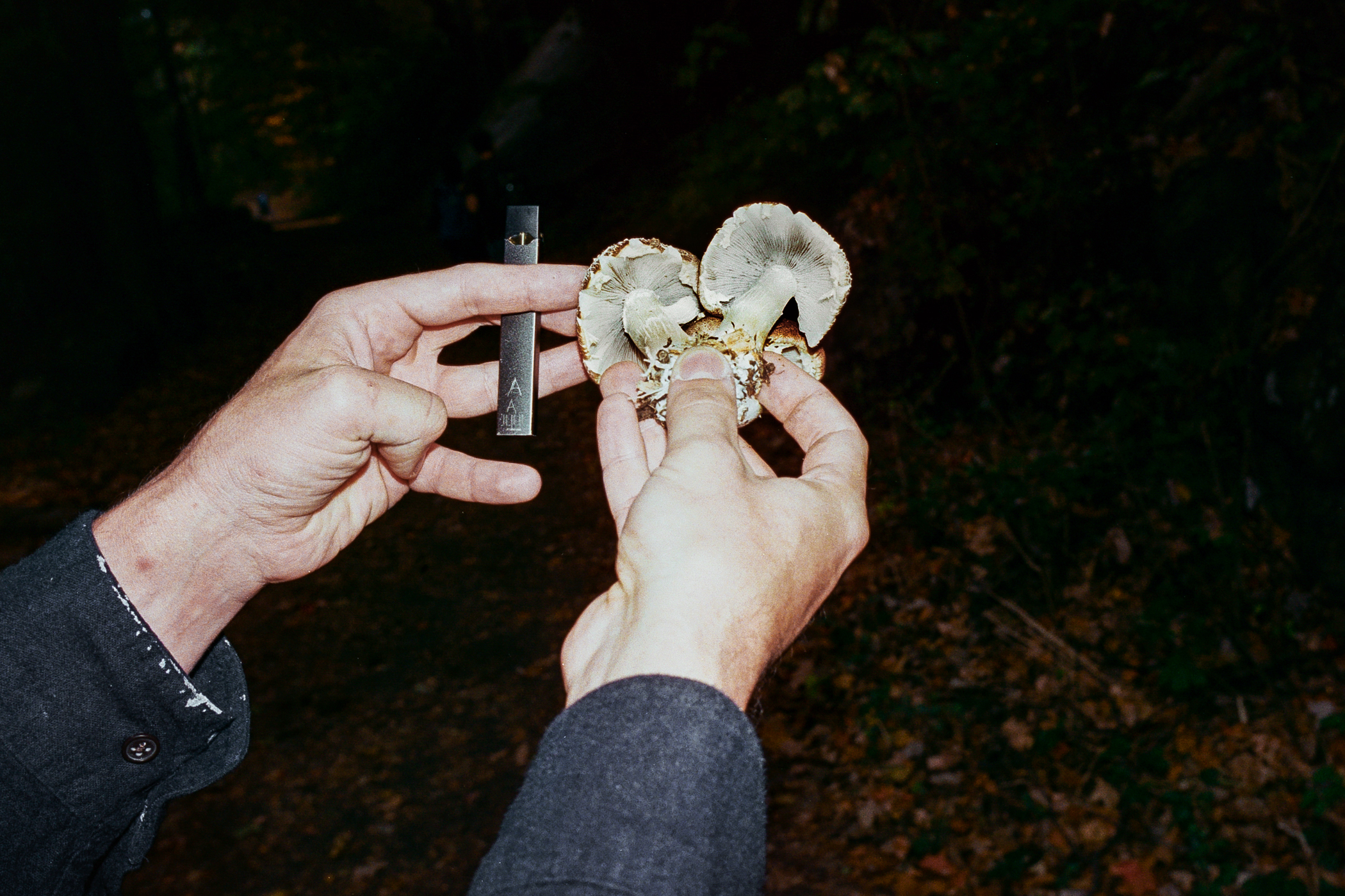
Above: Wine caps (Stropharia rugosoannulata), which are large edible mushrooms often found in landscaping wood chips
Once you’ve collected the mushrooms, what do you do with them? Any tips for preservation or storage?
I add them to everything — mixed in with scrambled eggs or pasta sauce, or even just microwaved with instant noodles. I’ve brined them as pickles; I’ve finely diced them to cook with butter and wine to make a duxelles paste that I freeze and use as a base; I’ve dried and powdered them to keep for soup stock, etc. Each fungus is slightly different in terms of preservation, but they can all be cooked and frozen. Some are best just to flavor broth (resin polypore), some are best fried (giant puffballs), some work any way (hen of the woods). I like eating fungi, and I think eating them adds to your understanding and enjoyment of them, but it isn’t my main attraction.
What’s your relationship with psilocybin mushrooms? Do you forage for those, as well?
I’ve certainly looked for Psilocybe species, but I personally haven’t found them. We have several native species in our range, but they aren’t especially common in our area. A friend found Psilocybe ovoideocystidiata in some landscaping in Chelsea this past May, though, and we enjoyed them. Mostly, I find other kinds of psychoactive fungi, like Amanita muscaria var. guessowii (North Eastern fly agaric) and Gymnopilus luteus (laughing gym) but haven’t tried them and am not especially inclined to.
I’ve had profound experiences on larger doses of psilocybin/LSD, but I am a bit wary of how harrowing the trip can be, so I end up doing them once every year or two. Most people would probably benefit from having a psychedelic experience at least once. Just experiencing your brain differently — having an expanded capacity for feeling and understanding kinship and beauty — it’s a revelatory thing to experience.

Above: Andrew Cannon cutting open the egg of the stinkhorn fungus (Phallus impudicus)
Do you have any feelings or thoughts about the psilocybin reform taking place in cities like Denver and Oakland this year?
In terms of legality, I’m for anything that ends the drug war. All drugs should be decriminalized and psychedelics should be legal. It is especially heartening that mushrooms are seeing their time in the sun since I personally have had positive experiences with them.
I’m definitely intrigued by medical studies involving psychedelics and depression/headaches/etc. But the main thing is that we need to stop putting people in jail for using substances. Whether or not they have medical application, and I’m sure they do, we’ve been eating psychedelic mushrooms since the Stone Age, and it’s everyone’s right to take them freely and safely.
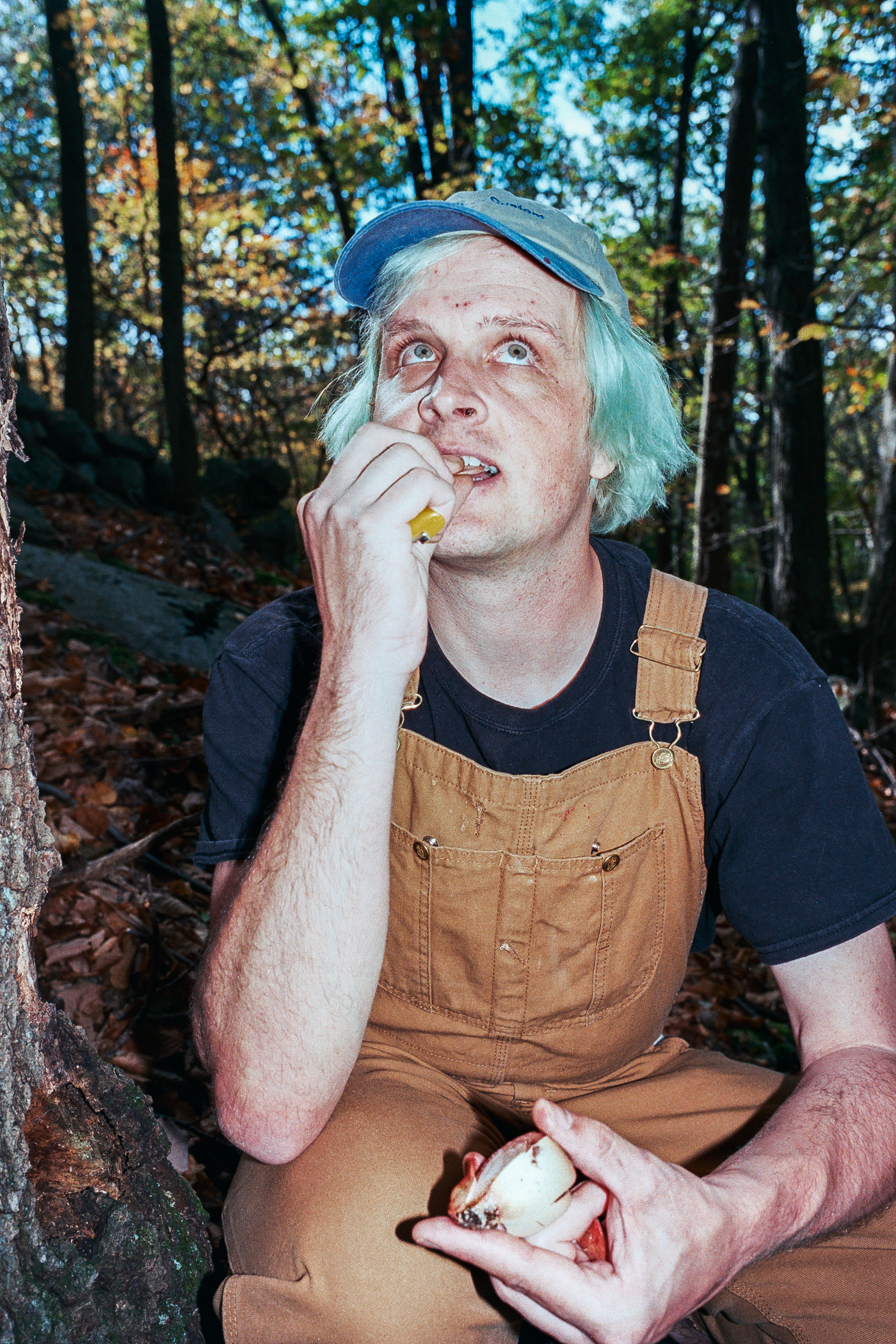
Above: Andrew Cannon eating thin slices of raw beefsteak polypore mushrooms
What is the most interesting or rare mushroom you’ve ever picked? What makes it special?
Phaeolepiota aurea, “the golden bootleg,” is a breathtaking mushroom to see in person. It isn’t edible or the rarest thing I’ve stumbled across, but it has a regal and subtle beauty to it. I’ve only seen it once, inauspiciously hiding under a roadside bush in a residential area near my studio last fall. It can be quite large and has a unique veil (the membrane that covers the gills until maturity and subsequently hangs on the stem as a skirt) covered in burnt orange warts that pattern it geometrically. I’ve been checking that bush all fall, but it has yet to reappear.
Another one, Monotropa uniflora or “ghost pipes,” is actually a flower, but it relates to fungi and is often mistaken as one. They’re quite common in the spring and summer, but no matter how many thousands I see, I love finding them and have taken more photos of them than probably anything else I find. They appear in little clusters in forested areas and are pure white, almost translucent. They’re myco-heterotrophs, plants that don’t photosynthesize (aka make their own food). They get their nutrients instead by parasitically skimming off of the mycorrhizal relationship between certain genera of fungi and trees. They have a mournful quality to them. They’re beautiful.
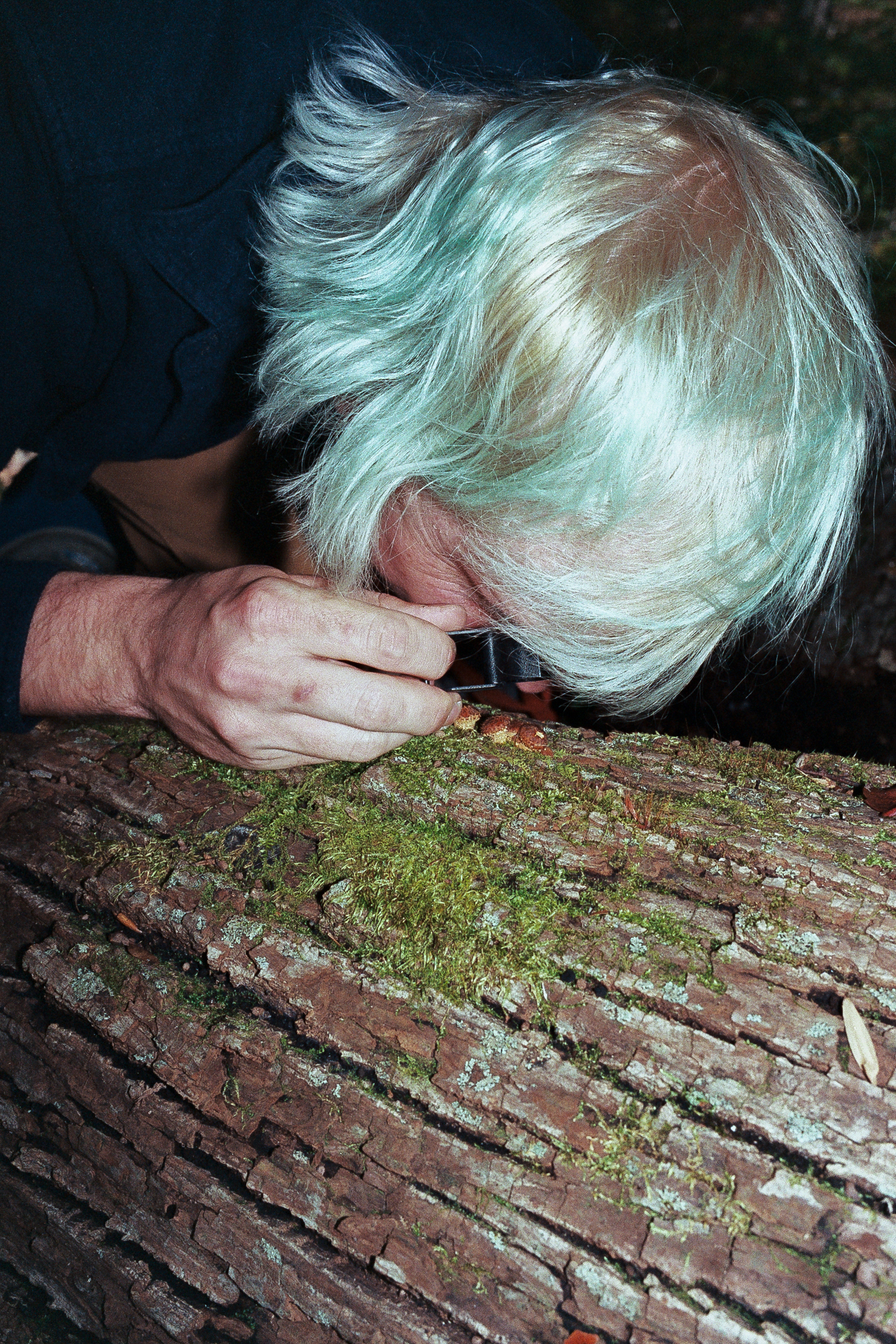
Above: Andrew Cannon looking at Pholiota species
What should people avoid while they’re foraging? Both in regards to the process of foraging, as well as particular types of fungus people should stay clear of!
I’d recommend being discreet about it, and not to signal to everyone around you that you’re collecting. There are laws in place about collecting fungi and they get enforced occasionally. I had a friend fined in Central Park for merely uprooting a fungi to take a photo of it. Of course, picking a mushroom is nothing like picking a plant. It’s more like picking an apple; you’re just taking the fruit from the organism. And if you collect something with mature gills, it’s already released millions, if not billions, of spores. But take what you’ll eat or what you’ll need to identify it back home with a book, and leave behind the young ones to grow.
The anglosphere is generally mycophobic. Many of us grow up being taught to not touch mushrooms, and we are told that they’re mostly poisonous. The truth is that they mostly aren’t, and that it’s safe to handle even deadly, poisonous mushrooms. The toxins have to be digested.
And learning how to identify fungi, especially many of the popular edible ones, is easier than most people suspect. Most people first learn how to identify the big rewarding edible fungi that don’t have lookalikes — like hen of the woods or giant puffballs. Then, with things that do have toxic lookalikes (like chanterelles or honey mushrooms), you should take time to learn how to tell the differences among the species so that you are fully sure what it is you’re collecting. I never eat something I’m not 100% sure about, and sometimes that takes seeing it over multiple seasons, as well as seeing the lookalikes. After all that, I’ll look at multiple sources to see what they have to say about edibility.

Above: A large clump of old and soggy honey mushrooms, growing on the roots of a dead hardwood
Do you consider foraging a life-long pursuit? Do you have any foraging goals that you’re still yet to achieve?
I do. As long as the mushrooms and plants keep growing, I’ll be out there. Goal-wise, I’d love to see the fungi and plants on other continents, especially in the rainforests of South America and Southeast Asia.
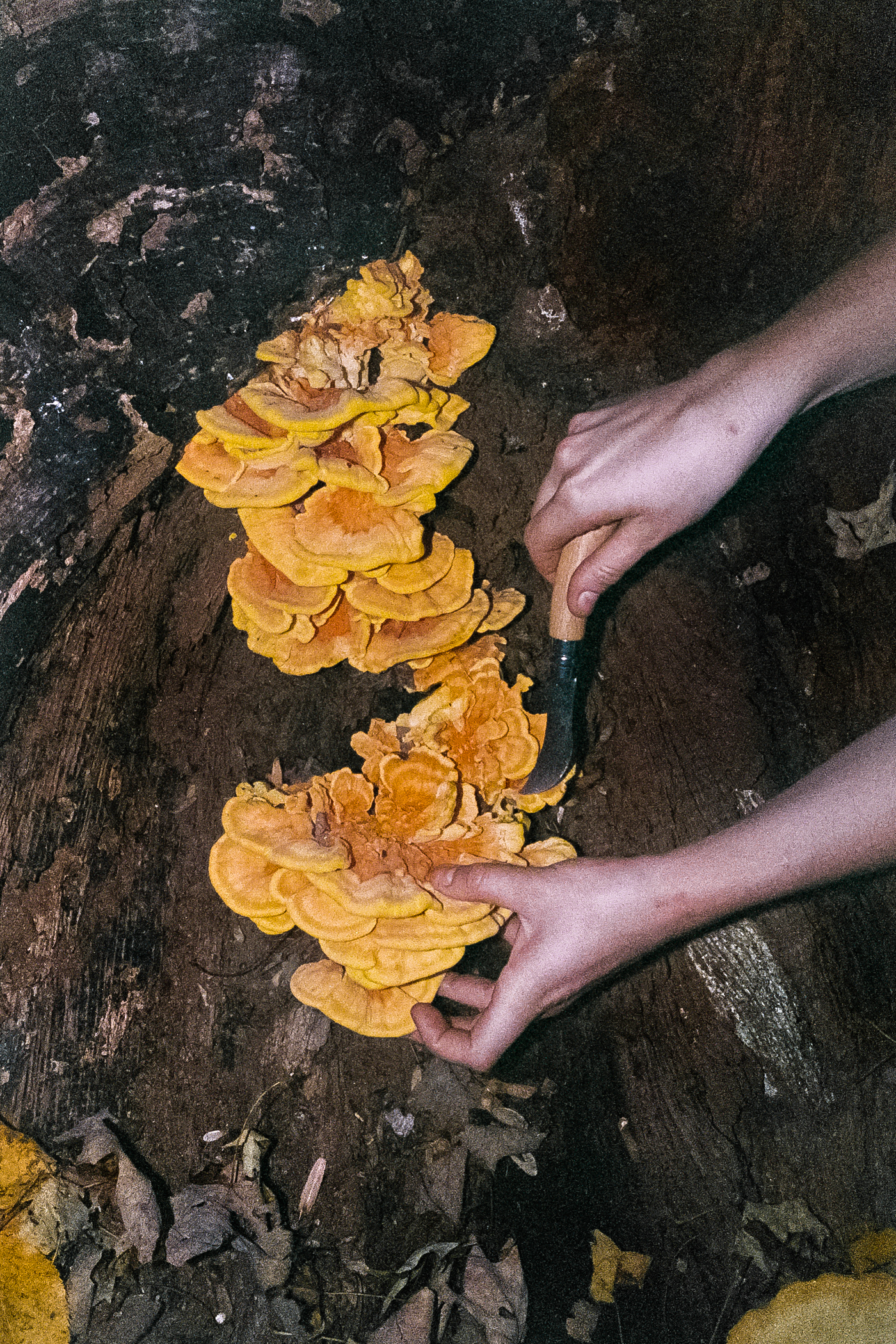
Above: Chicken of the woods (Laetiporus sulphureus)
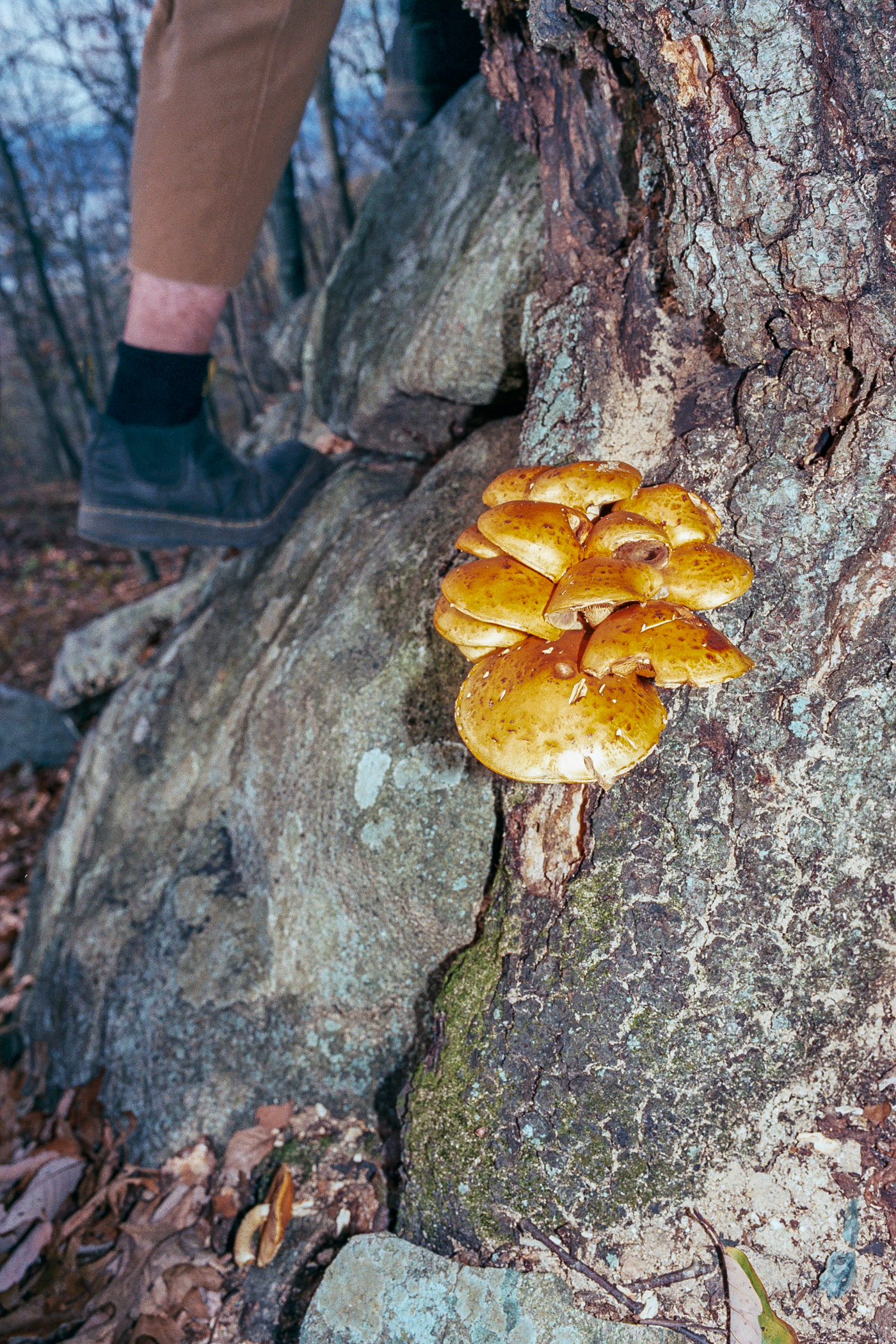
Above: Pholiota species

Above: Chicken of the woods (Laetiporus sulphureus).
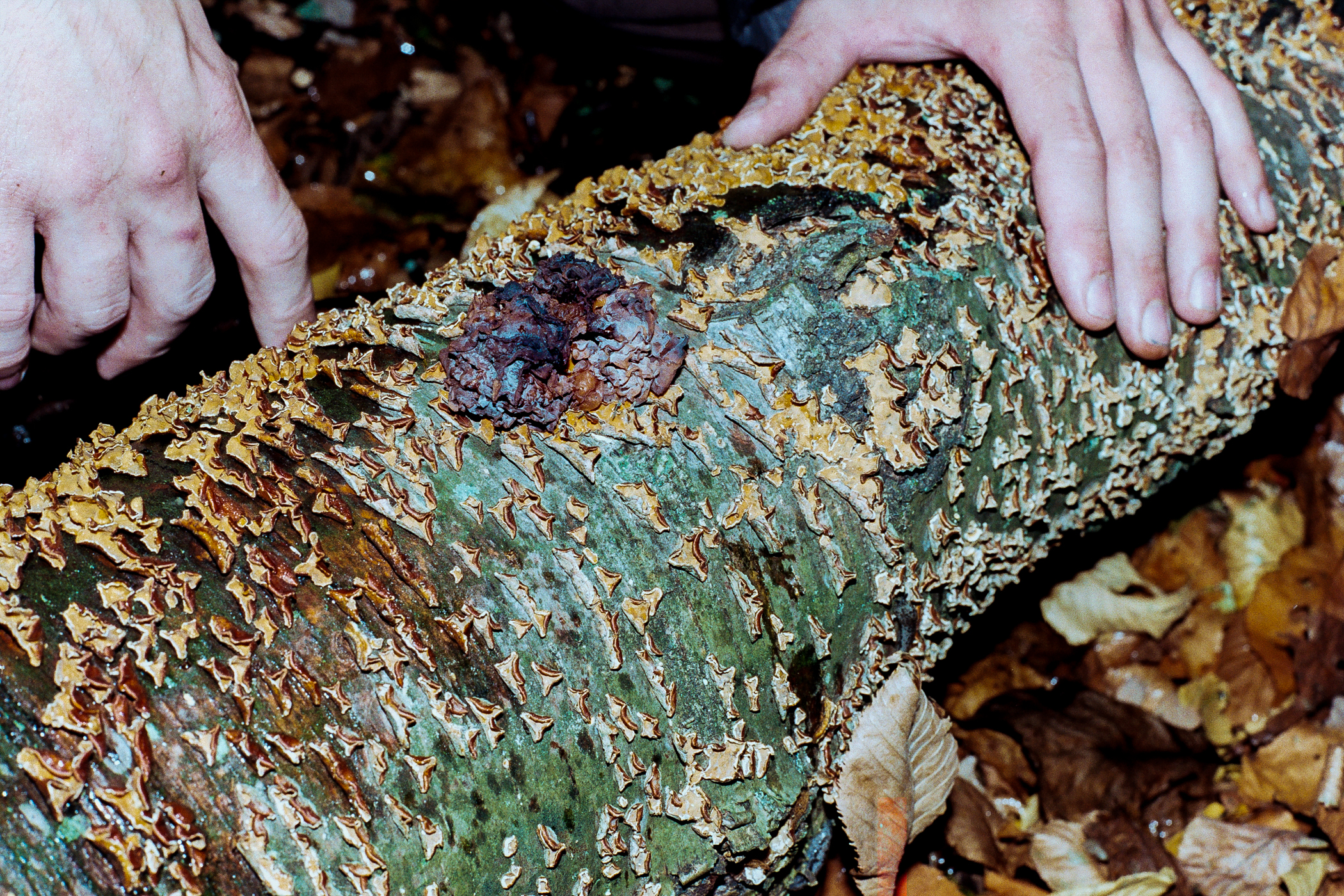
Above: Crowded parchment (Stereum complicatum) and an unidentified jelly fungus
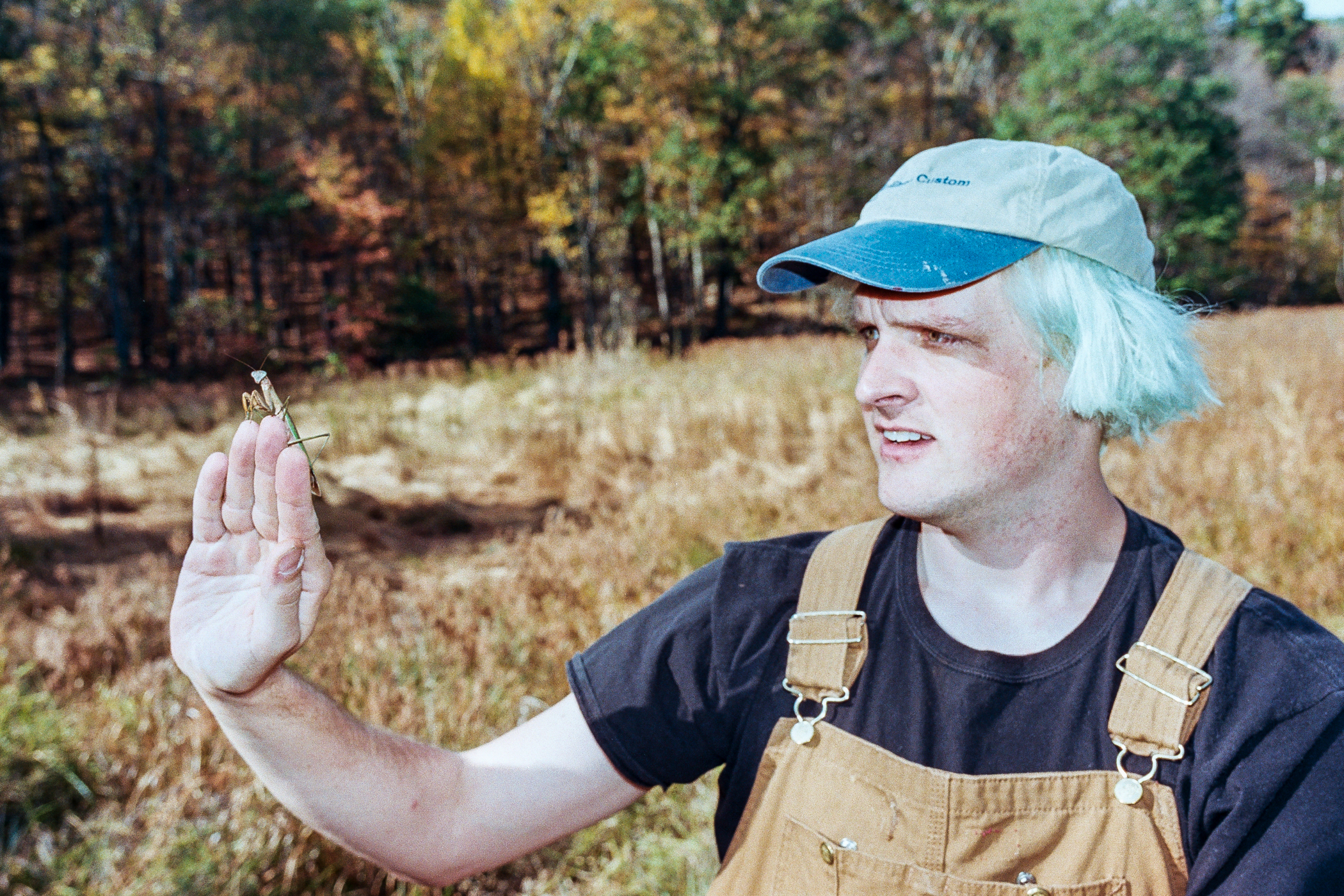
Above: Andrew Cannon holding a Chinese Mantis (Tenodera sanensis)
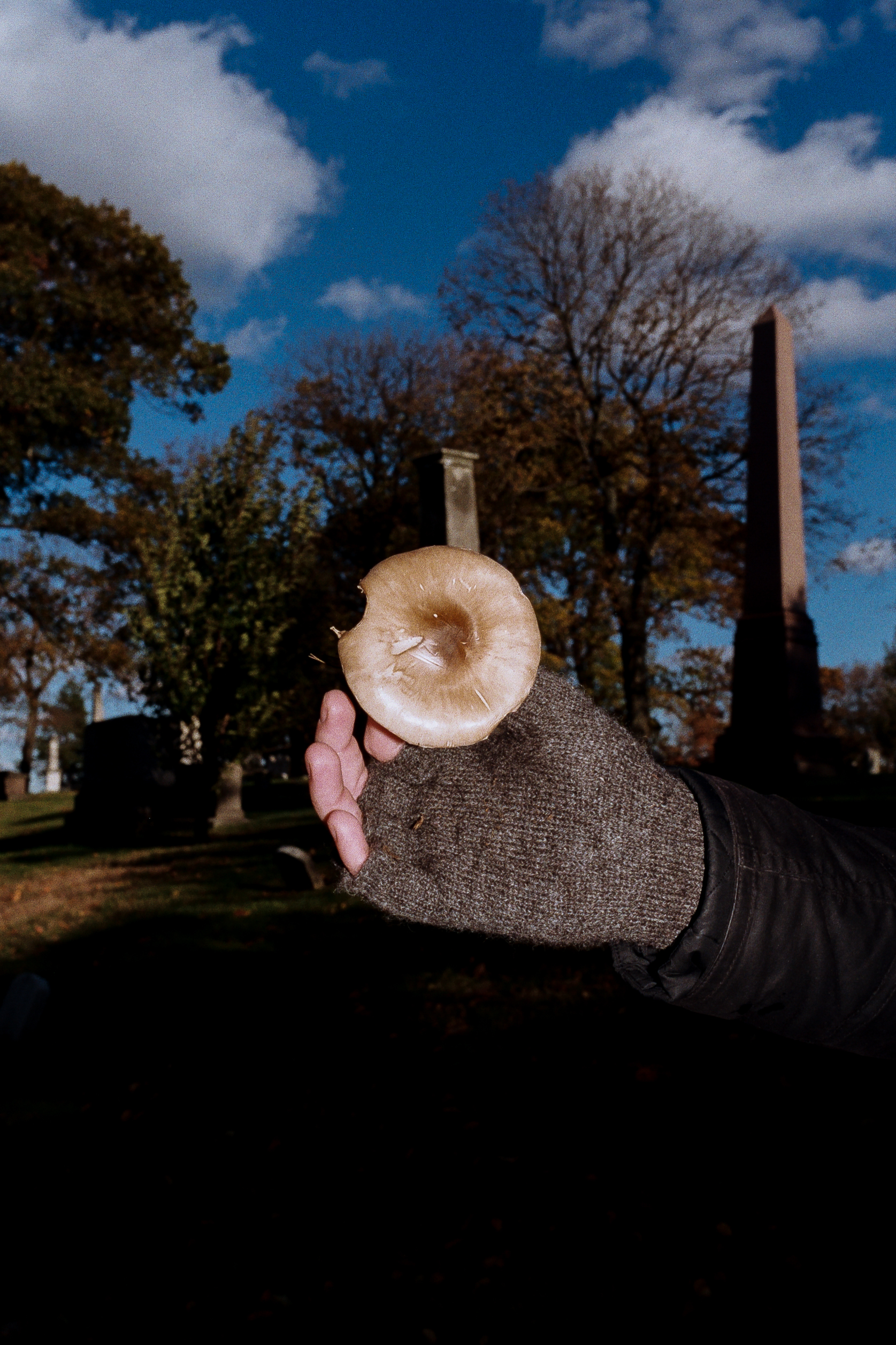
Above: Pluteus species
For more on Andrew Cannon, follow him on Instagram and visit his website
Follow OK McCausland on Instagram and visit her website for more


